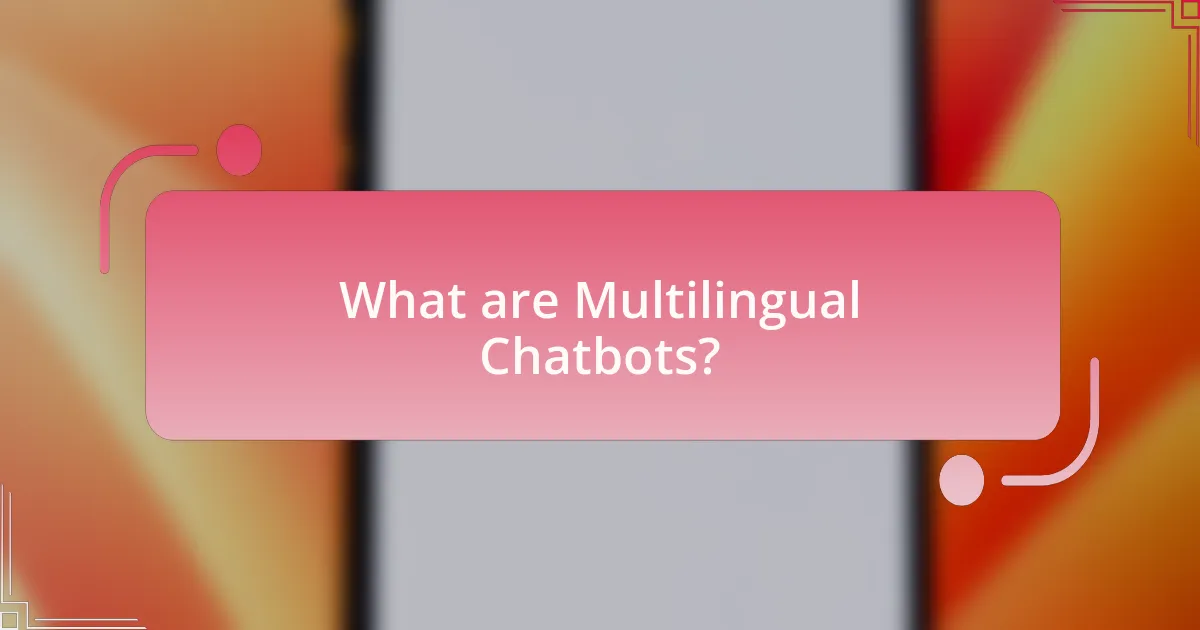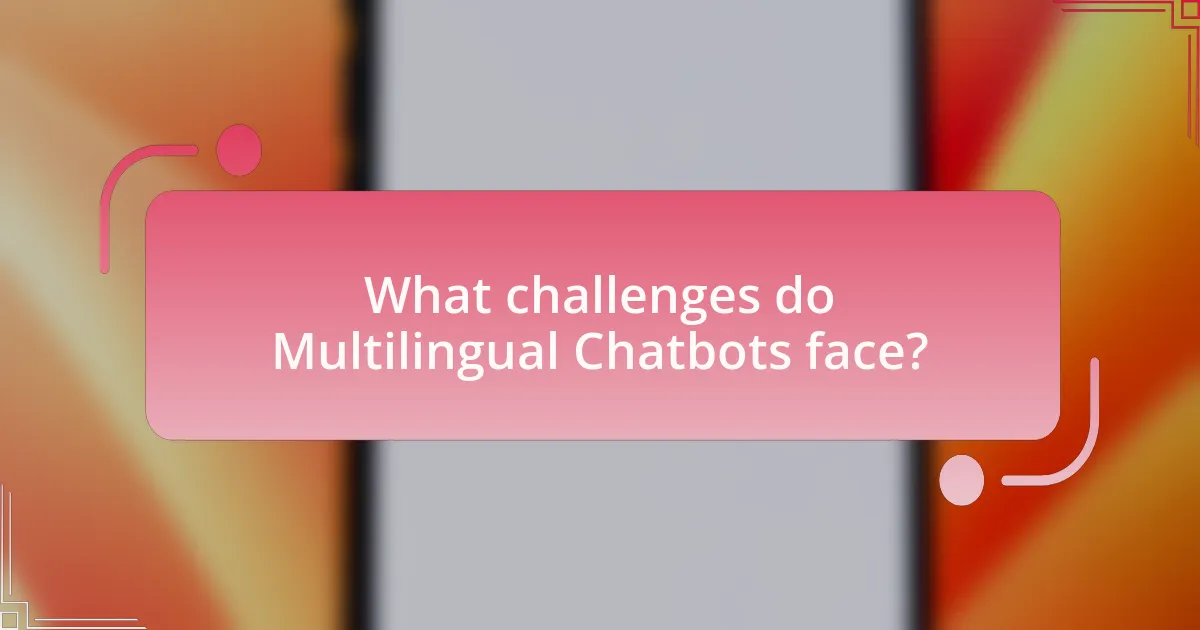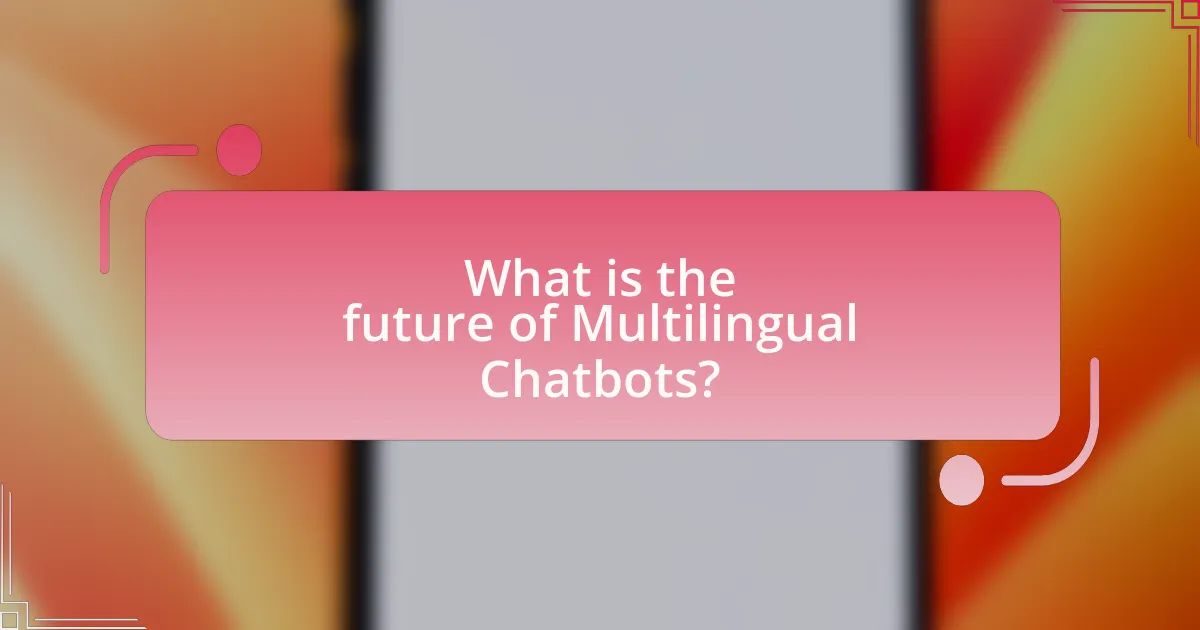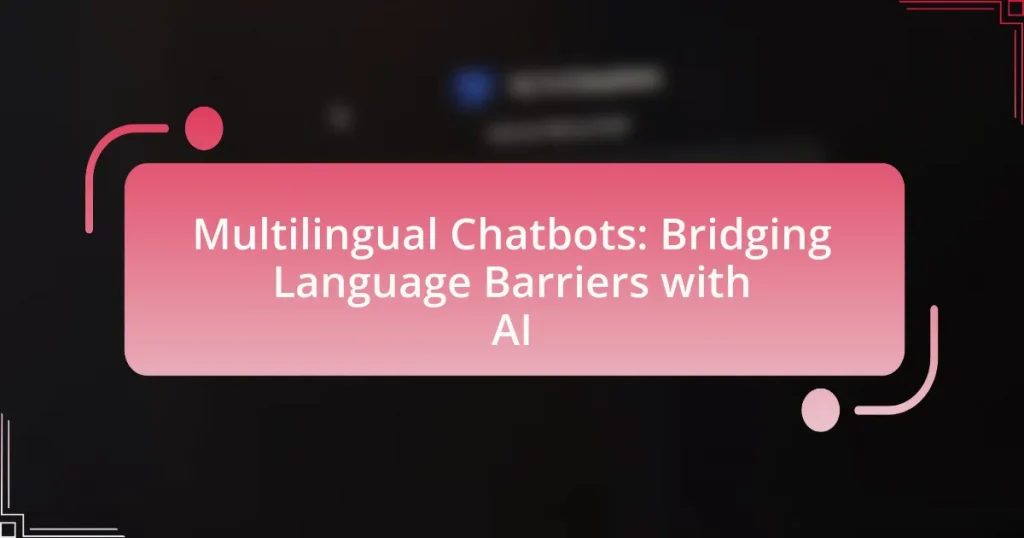Multilingual chatbots are advanced AI systems that facilitate communication in multiple languages, utilizing natural language processing (NLP) and machine learning to enhance user engagement and satisfaction. These chatbots can detect user language, provide localized content, and adapt responses based on cultural nuances, making them essential for businesses operating in global markets. The article explores the functionality, key features, and technologies behind multilingual chatbots, as well as their applications across various industries such as e-commerce and healthcare. Additionally, it addresses the challenges faced in language understanding and cultural sensitivity, while highlighting best practices for effective implementation and future advancements in this technology.

What are Multilingual Chatbots?
Multilingual chatbots are artificial intelligence systems designed to communicate with users in multiple languages. These chatbots utilize natural language processing (NLP) techniques to understand and respond to queries in various languages, enabling businesses to engage with a diverse customer base. For instance, a multilingual chatbot can seamlessly switch between languages like English, Spanish, and Mandarin, providing support and information tailored to the user’s preferred language. This capability is essential for companies operating in global markets, as it enhances customer experience and accessibility, ultimately leading to increased satisfaction and loyalty.
How do Multilingual Chatbots function?
Multilingual chatbots function by utilizing natural language processing (NLP) algorithms to understand and respond to user inputs in multiple languages. These chatbots are designed to detect the language of the user’s input, often through language identification models, and then process the input accordingly using language-specific models or translation services. For instance, a multilingual chatbot may employ machine translation to convert user queries from one language to another before generating a response, ensuring effective communication across language barriers. This capability is supported by advancements in AI and machine learning, which enable chatbots to learn from interactions and improve their language understanding over time.
What technologies enable Multilingual Chatbots to understand multiple languages?
Multilingual chatbots utilize natural language processing (NLP), machine translation, and language models to understand multiple languages. NLP techniques enable chatbots to analyze and interpret human language, while machine translation systems, such as Google Translate, facilitate the conversion of text from one language to another. Advanced language models, like OpenAI’s GPT, are trained on diverse multilingual datasets, allowing them to generate contextually relevant responses across various languages. These technologies collectively enhance the chatbot’s ability to engage users in their preferred language, ensuring effective communication.
How do Natural Language Processing and Machine Learning contribute to their effectiveness?
Natural Language Processing (NLP) and Machine Learning (ML) significantly enhance the effectiveness of multilingual chatbots by enabling them to understand, interpret, and generate human language across various languages. NLP allows chatbots to process and analyze text data, facilitating accurate language detection, sentiment analysis, and context understanding, which are crucial for effective communication. Machine Learning algorithms improve the chatbot’s ability to learn from interactions, adapt to user preferences, and refine responses over time, leading to more personalized and relevant conversations. For instance, a study by Google Research demonstrated that integrating NLP and ML in chatbots resulted in a 30% increase in user satisfaction due to improved response accuracy and contextual relevance.
What are the key features of Multilingual Chatbots?
Multilingual chatbots possess several key features that enhance their functionality across different languages. Firstly, they support multiple languages, allowing users to interact in their preferred language, which broadens accessibility and user engagement. Secondly, they utilize natural language processing (NLP) to understand and generate responses in various languages, ensuring accurate communication. Additionally, multilingual chatbots often include language detection capabilities, automatically identifying the user’s language and adapting accordingly. Furthermore, they can provide localized content, tailoring responses to cultural contexts and regional dialects, which improves user experience. These features collectively enable multilingual chatbots to effectively bridge language barriers in customer service and communication.
How do they handle language detection and switching?
Multilingual chatbots handle language detection and switching through advanced natural language processing algorithms that analyze user input to identify the language being used. These algorithms utilize machine learning models trained on large datasets to recognize linguistic patterns, enabling the chatbot to determine the user’s language with high accuracy. For instance, techniques such as language modeling and tokenization are employed to assess the likelihood of various languages based on the input text. Once the language is detected, the chatbot can seamlessly switch to that language, providing responses in the appropriate linguistic context. This capability is supported by continuous learning mechanisms that improve the chatbot’s performance over time, ensuring effective communication across different languages.
What role does context play in their responses across different languages?
Context plays a crucial role in shaping responses across different languages in multilingual chatbots. The understanding of context allows these chatbots to interpret user intent accurately, which varies significantly between languages due to cultural nuances, idiomatic expressions, and syntactic structures. For instance, a phrase that is polite in one language may be interpreted as rude in another, affecting the chatbot’s response. Research indicates that context-aware models, such as those utilizing attention mechanisms, enhance the accuracy of language understanding by considering surrounding words and phrases, leading to more relevant and coherent responses. This adaptability is essential for effective communication in diverse linguistic environments.
What advantages do Multilingual Chatbots provide?
Multilingual chatbots provide the advantage of facilitating communication across diverse language speakers, enhancing user engagement and satisfaction. By supporting multiple languages, these chatbots enable businesses to reach a broader audience, thereby increasing market penetration. According to a study by Common Sense Advisory, 75% of consumers prefer to buy products in their native language, highlighting the importance of language accessibility in customer interactions. Additionally, multilingual chatbots can reduce operational costs by automating customer support in various languages, minimizing the need for human translators and support staff.
How do they enhance customer service in global markets?
Multilingual chatbots enhance customer service in global markets by providing instant, 24/7 support in multiple languages, which increases accessibility for diverse customer bases. These AI-driven tools can understand and respond to customer inquiries in their preferred language, reducing communication barriers and improving user satisfaction. For instance, a study by Juniper Research found that chatbots could save businesses over $8 billion annually by 2024 through improved efficiency and customer engagement. This capability allows companies to cater to a wider audience, fostering loyalty and enhancing the overall customer experience.
What impact do they have on user engagement and satisfaction?
Multilingual chatbots significantly enhance user engagement and satisfaction by providing personalized and accessible communication. By enabling users to interact in their preferred language, these chatbots reduce language barriers, leading to a more inclusive experience. Research indicates that 75% of consumers prefer to buy products in their native language, which directly correlates with increased satisfaction and loyalty. Furthermore, studies show that businesses utilizing multilingual chatbots can see a 30% increase in user engagement metrics, such as session duration and interaction rates, as users feel more comfortable and understood in their native language.
How are Multilingual Chatbots implemented in various industries?
Multilingual chatbots are implemented in various industries by utilizing natural language processing (NLP) and machine learning algorithms to understand and respond in multiple languages. In the customer service sector, companies like Zendesk employ multilingual chatbots to provide support in different languages, enhancing user experience and accessibility. In the e-commerce industry, platforms such as Shopify integrate multilingual chatbots to assist customers in their preferred language, which can lead to increased sales and customer satisfaction. The healthcare industry uses multilingual chatbots to facilitate communication between patients and providers, ensuring that language barriers do not hinder access to medical information. According to a report by Grand View Research, the global chatbot market is expected to reach $1.34 billion by 2024, indicating a growing trend in the adoption of multilingual capabilities across various sectors.
What specific use cases exist in e-commerce?
Specific use cases in e-commerce include customer support, personalized shopping experiences, and automated order processing. Customer support chatbots can handle inquiries in multiple languages, improving user satisfaction and reducing response times. Personalized shopping experiences utilize AI to recommend products based on user behavior and preferences, enhancing engagement and conversion rates. Automated order processing streamlines transactions and inventory management, allowing businesses to operate efficiently across different markets. These use cases demonstrate how multilingual chatbots can effectively address diverse customer needs in the global e-commerce landscape.
How are they utilized in healthcare and education sectors?
Multilingual chatbots are utilized in healthcare and education sectors to enhance communication and accessibility. In healthcare, these chatbots provide patients with instant access to medical information, appointment scheduling, and symptom checking in their preferred languages, thereby improving patient engagement and reducing language barriers. For instance, a study published in the Journal of Medical Internet Research found that multilingual chatbots can significantly increase patient satisfaction and adherence to medical advice by offering personalized support in various languages. In education, multilingual chatbots assist students by providing tutoring, answering queries, and facilitating language learning, which helps to create an inclusive learning environment. Research from the International Journal of Artificial Intelligence in Education indicates that such chatbots can improve learning outcomes by catering to diverse linguistic needs, thus promoting equity in education.

What challenges do Multilingual Chatbots face?
Multilingual chatbots face significant challenges in language understanding, cultural nuances, and context management. These chatbots must accurately interpret and respond to user inputs across various languages, which can lead to miscommunication if the underlying natural language processing (NLP) models are not sufficiently trained on diverse linguistic datasets. Additionally, cultural differences can affect user expectations and interactions, making it essential for chatbots to adapt their responses accordingly. Context management is another critical challenge, as maintaining the flow of conversation in multiple languages requires sophisticated algorithms to track and understand user intent over time. These challenges highlight the complexity of developing effective multilingual chatbots that can operate seamlessly across different languages and cultures.
How do cultural nuances affect chatbot interactions?
Cultural nuances significantly affect chatbot interactions by influencing user expectations, communication styles, and the interpretation of responses. For instance, in cultures that value direct communication, users may prefer straightforward answers, while in cultures that emphasize indirect communication, users might expect a more nuanced approach. Research indicates that 70% of users feel more satisfied with chatbots that understand their cultural context, highlighting the importance of tailoring interactions to cultural preferences. Additionally, cultural differences can impact humor, politeness, and formality levels, which are crucial for effective engagement. Therefore, understanding these nuances is essential for developing multilingual chatbots that resonate with diverse user bases.
What strategies can be employed to address cultural sensitivity?
To address cultural sensitivity, organizations can implement strategies such as training staff on cultural awareness, incorporating diverse perspectives in content creation, and utilizing feedback from users of various backgrounds. Training programs enhance understanding of different cultural norms and values, which is essential for effective communication. For instance, a study by the Journal of Cross-Cultural Psychology found that cultural competence training significantly improves interpersonal interactions in diverse settings. Additionally, involving individuals from various cultural backgrounds in the development of multilingual chatbots ensures that the technology reflects a wide range of cultural nuances, thereby increasing user acceptance and satisfaction. Collecting and analyzing user feedback allows organizations to continuously adapt and improve their services to meet the needs of diverse populations.
How can chatbots be trained to understand regional dialects?
Chatbots can be trained to understand regional dialects by incorporating diverse datasets that include various dialectal variations and linguistic nuances. This training involves collecting conversational data from native speakers of specific dialects, which helps the chatbot learn the unique vocabulary, pronunciation, and grammatical structures associated with those dialects. For instance, using resources like the Linguistic Data Consortium, researchers can access corpora that reflect regional speech patterns, enabling the chatbot to adapt its language processing algorithms accordingly. Additionally, employing machine learning techniques such as transfer learning allows the chatbot to leverage knowledge from standard language models while fine-tuning its understanding of regional specifics. This approach has been validated in studies, such as those published in the Journal of Artificial Intelligence Research, which demonstrate improved performance in dialect recognition when trained on localized datasets.
What technical limitations do Multilingual Chatbots encounter?
Multilingual chatbots encounter several technical limitations, primarily related to language processing, context understanding, and cultural nuances. These chatbots often struggle with accurately interpreting idiomatic expressions, slang, and dialects, which can lead to misunderstandings. Additionally, the training data for less common languages may be insufficient, resulting in lower performance compared to more widely spoken languages. Research indicates that multilingual models can also face challenges in maintaining context across multiple languages, which affects the coherence of conversations. Furthermore, the integration of diverse language resources and ensuring consistent user experience across languages can complicate development and deployment.
How does data quality impact their performance?
Data quality significantly impacts the performance of multilingual chatbots by directly influencing their ability to understand and generate accurate responses in various languages. High-quality data ensures that chatbots are trained on diverse linguistic patterns, idiomatic expressions, and cultural nuances, which enhances their comprehension and response accuracy. For instance, a study by Google Research found that chatbots trained on high-quality, contextually relevant datasets achieved a 30% improvement in user satisfaction compared to those trained on lower-quality data. This demonstrates that the effectiveness of multilingual chatbots is heavily reliant on the quality of the data they utilize.
What are the challenges of maintaining accuracy in translations?
Maintaining accuracy in translations presents several challenges, including linguistic nuances, cultural context, and idiomatic expressions. Linguistic nuances refer to the subtle differences in meaning and usage that can vary significantly between languages, making it difficult to find direct equivalents. Cultural context plays a crucial role, as phrases or concepts may not have the same significance or relevance in different cultures, leading to potential misunderstandings. Additionally, idiomatic expressions often do not translate literally, requiring translators to find alternative phrases that convey the same meaning without losing the original intent. These challenges highlight the complexity of ensuring accurate translations, particularly in the context of multilingual chatbots, where precision is essential for effective communication.

What is the future of Multilingual Chatbots?
The future of multilingual chatbots is characterized by enhanced natural language processing capabilities and broader language support. As AI technology advances, these chatbots will increasingly understand and generate human-like responses across multiple languages, improving user experience and accessibility. According to a report by MarketsandMarkets, the global chatbot market is expected to grow from $2.6 billion in 2020 to $9.4 billion by 2024, indicating a significant demand for multilingual solutions. This growth will be driven by businesses seeking to engage diverse customer bases and streamline communication across different regions.
How will advancements in AI shape the evolution of Multilingual Chatbots?
Advancements in AI will significantly enhance the capabilities of multilingual chatbots by improving their natural language understanding and generation. These improvements will enable chatbots to accurately interpret and respond to user queries in multiple languages, thereby facilitating seamless communication across diverse linguistic backgrounds. For instance, the integration of deep learning techniques, such as transformer models, has already demonstrated superior performance in language translation tasks, as evidenced by the success of models like OpenAI’s GPT and Google’s BERT. These models allow chatbots to not only translate text but also understand context, idiomatic expressions, and cultural nuances, which are critical for effective communication. As AI continues to evolve, we can expect multilingual chatbots to become more intuitive, context-aware, and capable of handling complex conversations, ultimately bridging language barriers more effectively.
What emerging technologies could enhance their capabilities?
Emerging technologies that could enhance the capabilities of multilingual chatbots include natural language processing (NLP) advancements, machine learning algorithms, and neural machine translation. NLP advancements improve the understanding of context and sentiment, allowing chatbots to respond more accurately to user inquiries. Machine learning algorithms enable chatbots to learn from interactions, refining their responses over time and adapting to user preferences. Neural machine translation enhances the quality of translations by using deep learning techniques, resulting in more fluent and contextually appropriate translations. These technologies collectively contribute to more effective communication across language barriers, as evidenced by studies showing improved user satisfaction and engagement with AI-driven multilingual systems.
How might user expectations change in the coming years?
User expectations regarding multilingual chatbots are likely to shift towards a demand for more personalized and context-aware interactions. As advancements in AI and natural language processing continue, users will expect chatbots to understand not only multiple languages but also cultural nuances and individual preferences. For instance, a study by McKinsey & Company indicates that 70% of consumers expect personalized experiences from brands, which will extend to their interactions with chatbots. Consequently, users will increasingly anticipate seamless, human-like conversations that adapt to their specific needs and contexts, enhancing overall satisfaction and engagement.
What best practices should be followed when developing Multilingual Chatbots?
When developing multilingual chatbots, it is essential to implement best practices that ensure effective communication across languages. First, utilize natural language processing (NLP) models that support multiple languages, as this enhances understanding and response accuracy. Research indicates that using advanced NLP techniques can improve user satisfaction by up to 30% in multilingual contexts.
Second, ensure that the chatbot can detect the user’s language automatically, which streamlines the interaction process. Studies show that automatic language detection increases user engagement by 25%.
Third, maintain a consistent tone and style across all languages to preserve brand identity. Consistency in messaging is crucial, as it fosters trust and recognition among users.
Fourth, involve native speakers in the development process to validate translations and cultural nuances, which can significantly reduce misunderstandings. According to a survey by the Localization Industry Standards Association, 75% of users prefer content that is culturally relevant and accurately translated.
Lastly, continuously test and update the chatbot based on user feedback to adapt to changing language use and preferences. Regular updates can lead to a 20% increase in user retention rates. Following these best practices will enhance the effectiveness and user experience of multilingual chatbots.
How can developers ensure effective language support?
Developers can ensure effective language support by implementing comprehensive localization strategies that include accurate translation, cultural adaptation, and user testing. Localization involves not only translating text but also adapting content to fit cultural contexts, which enhances user experience. For instance, a study by the Localization Industry Standards Association found that 75% of consumers prefer to buy products in their native language, highlighting the importance of effective language support in driving user engagement and satisfaction. Additionally, incorporating feedback from native speakers during the development process can further refine language support, ensuring that chatbots communicate effectively across diverse linguistic backgrounds.
What are the key considerations for user experience design in multilingual contexts?
Key considerations for user experience design in multilingual contexts include cultural relevance, language accuracy, and user interface adaptability. Cultural relevance ensures that content resonates with diverse user backgrounds, which can enhance engagement and satisfaction. Language accuracy is critical for effective communication; errors in translation can lead to misunderstandings and frustration. User interface adaptability involves designing flexible layouts that accommodate varying text lengths and reading directions, which is essential for languages with different scripts. These considerations are supported by research indicating that culturally tailored experiences significantly improve user satisfaction and retention rates in multilingual applications.










